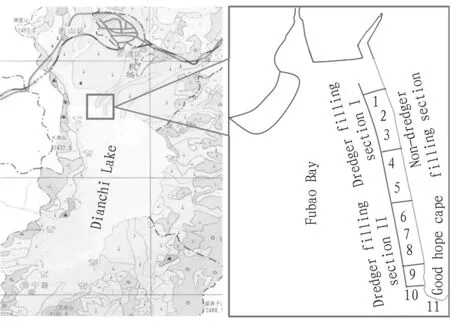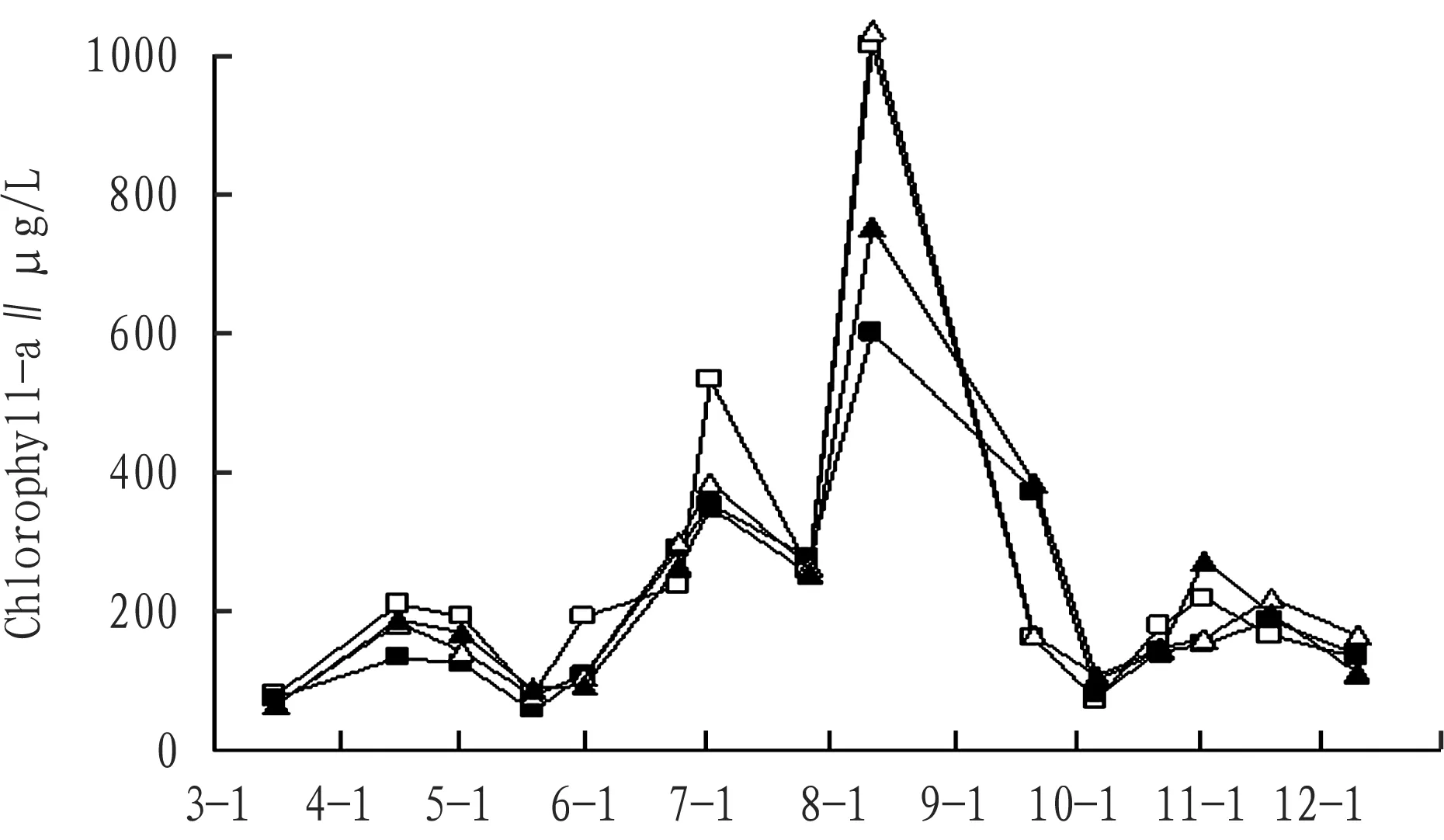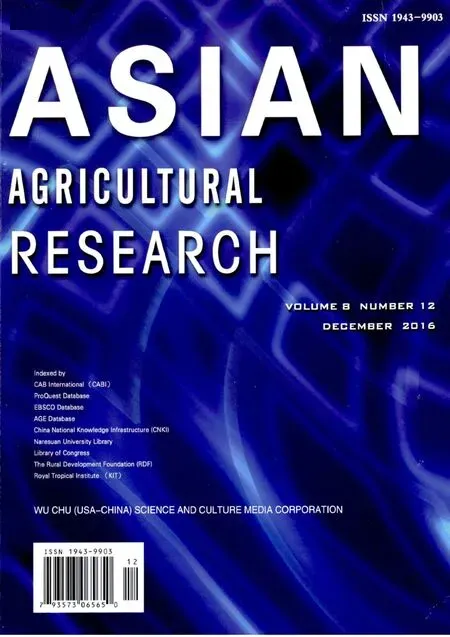The Correlation between the Variation of Dissolved Inorganic Carbon Content and Cyanobacterial Blooms in Fubao Bay of Dianchi Lake
, ,
1. Anhui Research Academy of Environmental Science, Hefei 230022, China; 2. College of Life Sciences, Central China Normal University, Wuhan 430079, China
1 Introduction

Using water body of ecological restoration area in Fubao Bay of Dianchi Lake as research object, we studied temporal and spatial dynamic variation of dissolved inorganic carbon (DIC) in eutrophic water body, and explored rules of variation in DIC in natural water body in the process from outbreak to extinction of cyanobacterial blooms, to provide a basis for effective prevention and control of cyanobacterial blooms.
2 Materials and methods
2.1DistributionofsamplingpointsandsamplingmethodThe east shore of Fubao Bay belongs to a whole area. Considering deep water of vertical embankment, poor water quality, and low transparency, strong erosion of winds and waves, and impossible to restore aquatic vegetation in a short term, it has implemented sediment dredging and filling demonstration project. According to dredger filling, we divided this area into two dredger filling sections (dredger filling section I and dredger filling section II), non-dredger filling section, and an undeveloped area (good hope cape).

Fig.1MapfordistributionofsamplingpointsinFubaoBayofDianchiLake
In ecological restoration area of Fubao Bay, we selected 11 sampling points: 3 areas of dredger filling section I (dredger filling section 1, 2, and 3), 2 areas of non-dredger filling section II (non-dredger filling section 4 and 5), 3 areas of dredger filling section II (dredger filling section 4 and 5), and the 3 areas of good hope cape (good hope cape 9, 10, and 11); statistical results were average value of sampling points in each area. In March to December, 2007, we collected surface water of each sampling point in ecological restoration area of Fubao Bay of Dianchi Lake by the organic glass sampler. At the same time, we measured the water temperature and pH value. Sampling frequency was 2 times a month (one time for some month due to force majeure). Sampling time was controlled in the morning 9: 00 to 11: 00.
2.2MeasurementandcalculationmethodofdissolvedinorganiccarbonWe measured the alkalinity of water in accordance with the national standard[4], and calculated the inorganic carbon concentration by the following method[5].



CT= {[total alkalinity]+[H+]-[OH-]} /(α1+2α2)
[CO2] =CTα0
whereK1andK2are first and second order dissociation constants of H2CO3,αis carbonic acid equilibrium coefficient,CTand is concentration of inorganic carbon.
2.3Measurementofchlorophyll-aconcentrationWithin 12 hours after sampling, we measured chlorophyll-a concentration by 90% acetone extraction method[6], and measured the absorbance using UV2401 ultraviolet-visible Spectrophotometer (Japanese GL Sciences).
2.4StatisticalanalysisWe used Spearman correlation analysis tool and linear regression analysis tool of SPSS 12.0.
3 Results and analysis
3.1Distributionandvariationofchlorophyll-ainwaterbodyofFubaoBayIn March to December, 2007, the average chlorophyll-a content in water body of dredger filling section I and dredger filling section II (249.6 μg/L and 236.4 μg/L respectively) was higher than in non-dredger filling section and good hope cape. From Fig. 2, it can be seen that the variation trend of chlorophyll-a in 4 sampling areas was basically the same. The chlorophyll-a in water body rose from March, reached a peak in the middle of April, and started to decline to the lowest value in the middle of May. In this period, chlorophyll-a in water body of Fubao Bay was consistent with outbreak and extinction of cyanobacterial blooms. From the end of May to the beginning of June, it was the recovery period of cyanobacterial blooms, till July to September, it was large outbreak of cyanobacterial blooms, and the chlorophyll-a in water body reached the maximum value in middle of August, and later, it declined with the lapse of time; from October to December, it was extinction period of cyanobacterial blooms, and planktonic algae withaphanizomenonflo-saquaeas major part appeared again[7].

Note: -□- Dredger filling section I; -■- Non-dredger filling section; -△- Dredger filling section II; -▲- Good hope cape
Fig.2Variationofchlorophyll-ainwaterbodyofFubaoBay


The variation of water temperature with time in four sections was basically consistent. In March to December, 2007, the average temperature was higher than 19.7 ℃.
3.3CorrelationbetweenplanktonicalgaeandenvironmentalfactorslikeinorganiccarboninwaterbodyofFubaoBay

4 Discussions
4.1ReasonsfordynamicvariationofplanktonicalgaeandinorganiccarbonThe high average content of chlorophyll-a in dredger filling section I and dredger filling section II is possibly due to slow exchange of water in the lake because of closure of enclosure. Besides, the stability of the sediment is poor in the short time, vulnerable to violent erosion of winds and waves, leading to release and re-suspension of nutrient salts in sediment, and also leading to massive growth of planktonic algae. The Haihe River is one of the major rivers receiving pollutants in Fubao Bay, and one of the main channels for receiving pollutants of surrounding areas. The water quality is class V. Every year, large volume of pollutants such as nitrogen and phosphorus are discharged to Fubao Bay. The north side of dredger filling section I faces the estuary of Haihe River, leading to high content of nitrogen and phosphorus in water body of this area and providing nutrient foundation for massive growth of phytoplankton.




Note: -□- Dredger filling section I; -■- Non-dredger filling section; -△- Dredger filling section II; -▲- Good hope cape
Fig.3Variationofinorganiccarbon,watertemperatureandpHvalueofwaterbodyinFubaoBayofDianchiLake
Table1Correlationbetweenchlorophyll-aconcentrationandinorganiccarbon

Chlorophyll-aDredgerfillingsectionINon-dredgerfillingsectionDredgerfillingsectionIIGoodhopecapeSpearmanCorrelationcoefficientPNSpearmanCorrelationcoefficientPNSpearmanCorrelationcoefficientPNSpearmanCorrelationcoefficientPNDIC-0.0290.91915-0.556*0.03115-0.632*0.02115-0.532*0.04115HCO-3-0.0570.84015-0.525*0.04415-0.632*0.02115-0.550*0.03415CO2-0.3070.26615-0.709**0.00315-0.694**0.00415-0.718**0.00315CO2-30.584*0.022150.893**0.000150.817**0.000150.918**0.00015pH0.4220.117150.728**0.002150.637*0.011150.614*0.01515Watertemperature0.4770.072150.4410.099150.4920.063150.556*0.03115
Note:*significantly correlated (P< 0.05);**extremely significantly correlated (P< 0.01).


In eutrophic water, the pH value of water is mainly controlled by biological processes. Wang Zhihongetal.[15]studied the correlation between reservoir eutrophication and pH value and concluded that in the eutrophication process, especially at the stage of the outbreak of bloom, pH value of upper layer of water will rise rapidly, and the daily fluctuation of pH value is large. Therefore, life activities of planktonic algae promote rise of pH value to a certain extent.
Besides, the water temperature is closely connected with growth of planktonic algae, abundance of bloom of blue green algae and chlorophyll-a concentration are significantly positive correlated with water temperature, and higher water temperature is favorable for blue green algae becoming dominant population and outbreak of blooms of blue green algae[16-21]. This is basically the same as this study, indicating that water temperature has obvious inhibitory function for growth of blue green algae.
5 Conclusions

(ii) When the water body is under the restriction of inorganic carbon, blue green algae will rapidly grow, and then form the dominant population, finally evolve into blooms of blue green algae. Under dual action of restriction of inorganic carbon and shading of blooms of blue green algae, it leads to extinction of submerged plants and deteriorates the eutrophication process.
[1] LI WC, LIU ZW, HU ZH,etal. Studies and demonstration engineering on ecological restoration technique in the Littoral Zone of Dianchi Lake: The state and cause of environmental depravation and ecological degradation[J].Journal of Lake Science, 2004, 16( 4) : 305-311.(in Chinese).
[2] LI XH, HU WP, YANG LY,etal. Diurnal variation of carbon dioxide flux on water-air interface of Meiliang Bay, Taihu Lake in wintertime[J].Chinese Journal of Ecology, 2005, 24( 12) : 1425-1429.(in Chinese).
[3] JI XY, CUI GB, YANG LY,etal. Measurement of the CO2 flux on the water-air interface of Taihu Lake[J].Chinese Journal of Environmental Science, 2006, 27( 8) : 1479-1486.(in Chinese).
[4] Ministry of Environmental Protection of the People’s Republic of China.The analytical method of water and waste water monitoring[M].Beijing: China Environmental Science Press, 2002: 120-124, 201-205.(in Chinese).
[5] YANG HX. Water chemistry[M].Beijing: Science Press, 1987: 129-133.(in Chinese).
[6] ELEY JH. Effect of carbon dioxide concentration on igmentation in the blue-green alga Anacystis nidulans[J]. Plant & cell physiology, 1971, 12: 311-316.
[7] LI Y, ZHANG M, LIU RN. The temporal and spation variation of the cyanobacteria which caused the water bloom in the Dianchi Lake, Kunming, China[J].Journal of Yunnan University(Natural Sciences), 2005, 27( 3) : 272-276.(in Chinese).
[8] VERMAAT J E. Periphyton removal by freshwater micrograzers[M]/ /VANVIERSSEN W, HOOTSMANS M, VERMAAT J. Lake Veluwe, a macrophyte-dominated system under eutrophication stress[M].Dordrecht, the Netherlands: Kluwer Academic Publishers, 1994: 213-249.
[9] HUANG FR. On the characteristics of rare earth element and geochemical evolution of shale phosphate in lower cambrian series of the Dian Lake of Yunnan[J].Chinese Rare Earths, 1995, 16( 4) : 48-51.(in Chinese).
[10] LIU YD, FAN X, HU ZY. Study on Chinese phycology[M]. Wuhan: Wuhan Publishing House, 2001.(in Chinese).
[11] ZHANG BY, LI YG, LI ZK,etal. Effects of temperature, light intensity and pH on photosynthesis and growth rate of haematococcus pluvialis[J].Oceanologia Et Limnologia Sinica, 2003, 34( 5) : 558-565.(in Chinese).
[12] WANG ZF, ZHANG Q, LV HY. Effects of temperature, salinity, light and pH on the growth of red tide org analysis prorocentrum mican[J]. Oceanologia Et Limnologia Sinica, 2001, 32( 1) : 15-18.(in Chinese).
[13] ZHAO MX, HAN BP. Analysis of factors affecting cyanobacteria bloom in a tropical reservoir (Tangxi Reservoir, China)[J].Acta Ecologica Sinica, 2005, 25( 7) : 1554-1560.(in Chinese).
[14] BERMAN-FRANK I, KAPLAN A, ZOHARYT,etal. Carbonic anhydrase activity in the bloom-forming dinoflagellate Peridinium gatunense[J]. Journal of Phycology, 1995, 31: 906-913.
[15] WANG ZH, CUI FY, AN Q,etal. Study on influence of pH on the advance of eutrophication in reservoir[J].Water & Wastewater Engineering, 2004, 30( 5) : 37-41.(in Chinese).
[16] ZHAO W, DONG SL, LI DS,etal. The primary productivity of phytoplankton in saline-alkaline ponds[J].Acta Hydrobiologica Sinica, 2003, 23( 1) : 47-54.(in Chinese).
[17] ZHNEG WF, ZENG ZQ. High temperature adaptation of fresh water Cyanobacterium[J]. Journal of Lake Science, 1994, 6( 4) : 356-363.
[18] NALEWAJKO C, MURPHY TP. Effects of temperature and availability of nitrogen and phosphorus on the abundance of Anabaena and Microcystis in Lake Biwa, Japan: An experimental approach[J]. Limnology, 2001, 2: 45-48.
[19] LIN YX, HAN M. The study growth factor of the Microcystis aeruginosa Kiitz during eutrophication of Dianchi Lake[J]. Advances in Environmental Science, 1998, 6( 3) : 82-87.
[20] CHEN YW, QIN BQ, GAO XY. Prediction of blue-green algae bloom using stepwise multiple regression between algae & related environmental factors in Meiliang Bay, Lake Taihu[J]. Journal of Lake Science, 2001, 13(1) : 63-71.
[21] WANG W, FANG ZF, YU W D. Research on restricted factors of Cyanophyceae density in Qian-dao Lake[J]. Heilongjiang Environmental Journal, 2003, 27( 2) : 60-63.
 Asian Agricultural Research2016年12期
Asian Agricultural Research2016年12期
- Asian Agricultural Research的其它文章
- How to Improve Tea Farmers’ Livelihoods in the Sightseeing Place along Lijiang River Valley?
- Brand Construction of Agricultural Enterprises: A Case Study of Hubei Hanway Ecological Agriculture Group
- Impact of Online Comments on Purchase Intention of College Student Consumers under Online Shopping
- Empirical Research on Farmer’s Breaching Behavior in Order Contract
- Suitability Evaluation of Garden Landscape in Chizhou Residential Area
- Effect of Vector Density and Competence on Macromolecular Vector Transformation Efficiency
